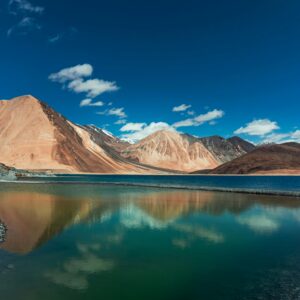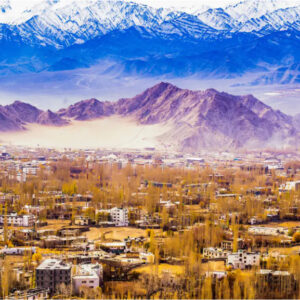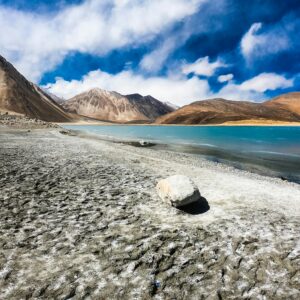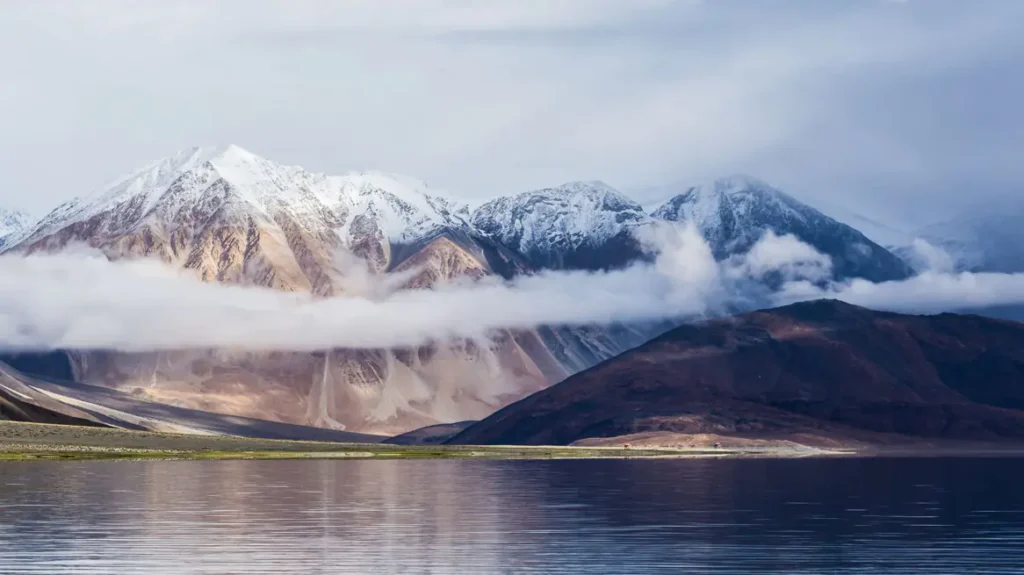Introduction
Few places on the globe can inspire the same sense of wonder and tranquility as Pangong Lake, or Pangong Tso, located in Ladakh, India. Pangong Lake is one of the highest saltwater lakes in the world, situated at 14,270 feet (4,350 meters) above sea level. Pangong Lake’s blue water extends infinitely in every direction against rugged mountains. It is truly an extraordinary sight; to put it simply, it is like a dream.
Pangong Tso is an important travel destination in Ladakh, a place to witness changing hues of blue and experience tranquility. Whether you are doing a road trip and looking for adventure, creating a frame for a photo, or looking for a chance to simply relax in nature, Pangong Lake will offer a memorable experience in the Himalayas.
In this detailed travel guide to Pangong Lake by Travelogear Holidays, we will discuss everything you need to know–how to get there, when to go, what to see, where to stay, travel tips, and the most frequently asked questions–to help you plan the perfect trip, and one of the great trips of your life.



About Pangong Lake
Pangong Tso (Tso means ‘lake’ in Tibetan) is situated in eastern Ladakh, extending from India to Tibet, with roughly one-third of the lake in India and the balance in China. It is almost 134 kilometers long and displays remarkable variability of color — ranging from azure, to rich blue, to shades of green and grey depending on the sunlight.
At such high altitude, the lake remains frozen throughout the winter and turns into a sheet of ice surrounded by snow-capped peaks that capture the same ethereal beauty and charm you find at Pangong Tso. Although the lake is saline, the cold brings it to an extreme, adding to the charm.
The lake became hugely popular after being featured in movies like 3 Idiots and Jab Tak Hai Jaan, but what is more stunning than its fame in films is that it truly is one of the most beautiful places to visit in Ladakh.
Geography & Significance
Pangong Lake is located between the Chang Chenmo mountain range to the north and the Pangong range to the south. The lake’s elevation results in lower oxygen levels, crisp air, and a pristine landscape.
The vicinity of the lake is a popular area for migratory birds, especially in the summer. Birdwatchers and photographers may see bar-headed geese, Brahminy ducks, and seagulls.
For the residents and Buddhist monks, Pangong Tso is more than just a lake; it is a sacred site, a place where the earthly and divine collide in pure silence.
Best Time to Visit Pangong Lake
Selecting an appropriate time to go to Pangong Lake is essential to experience its beauty in the best possible way. The region has extreme temperatures and strategic planning go hand in hand with comfort.
1. Summer (May to September) – The Best Season:
- Temperature: 5°C to 25°C.
- The roads from Leh to Pangong are open and the lake reflects its famous blue colours.
- Great for camping, photos, and possible excursions to nearby settlements.
- Ladakh Festival and Sindhu Darshan happen during this time.
2. Winter (October to February) – For the Courageous:
- Temperature: It can get to -15°C or lower.
- The lake is frozen solid and a surreal white desert of ice and snow is the result.
- Best for people seeking solitude and peace, but can be difficult to get to as the roads will be closed.
Travelogear Holidays offer guided winter trips for those who wish to see this phenomenon.
3. Monsoon (July to August):
- Rainfall is limited in Ladakh, but the terrain may vary in difficulty due to melting snow.
- However the landscape is vibrant and lush and makes for great photos.
Best Times to Visit:
May to September is considered the best time to travel and view the landscape in comfort.
How to Reach Pangong Lake
A part of the journey to Pangong is an adventure in itself! The distance from Leh to Pangong Lake is one of the most picturesque drives in the Himalayas.
By Road from Leh
Distance: About 160 km
Time: 5-6 hours by car or bike
Route: Leh – Karu – Chang La Pass – Tangtse – Pangong Lake
The road passes through Chang La Pass (17,590 ft), the third highest motorable pass in the world. Travelogear Holidays will provide private taxis, SUV rentals, and biking tours to keep you safe and comfortable on this high-altitude trip.
By Air
The nearest airport is Kushok Bakula Rimpochee Airport in Leh, which is well connected with major Indian cities – Delhi, Mumbai, and Srinagar. After getting to Leh, you can hire a cab or motorcycle to go on to Pangong.
By Bike:
For those who love to ride, a ride from Leh to Pangong on a Royal Enfield or Himalayan is a dream come true for bikers. It is one of the best segments of bikes in the world due to the rugged terrain, tight turns, and awe-inspiring views.
Best Places to Visit Around Pangong Lake
Spangmik Village
As the closest village to Pangong Lake, Spangmik Village is the most common area for camping. The location is peaceful and has expansive sunrise and sunset views. You can meet locals and experience their hospitality in Ladakh.
Lukung
Lukung is the “Gateway to Pangong,” and it is the first place that travelers visit around the lake. This village has basic amenities, and there are some good campsites that offer a fabulous view of the stars at night.
Merak & Man Village
On the southern banks, these two villages are excellent escapes with some great panoramic views. You can also take some short treks and see what the Ladakhi lifestyle is like.
Chang La Pass
On the way to Pangong, Chang La has some fabulous views of the snow-covered peaks. Chang La is one of the highest mountain passes you can reach by road. It is an exciting place to stop on the trip to Pangong.
Tangtse
Tangtse is a small village on the road to Pangong with monasteries and some local restaurants where you can get a feel for local life in Ladakh.
Hemis Monastery
On the way back to Leh, stop at Hemis Monastery, a large and rich monastery in Ladakh. Hemis Monastery is known for its vibrant Hemis Festival celebration.
Top Things to Do at Pangong Lake
1. Camping near the lake
It is a unique experience to spend a night by the sparkling blue waters of Pangong. As the stars fill a clear sky, the stillness of the mountains becomes almost meditative.
Travelogear Holidays operates eco-camps with all the comforts of home—bed linen, food, and a guided experience of stargazing.
2. Photography
Pangong is a photographer’s delight with a different shade every minute—a landscape made for reflections, silhouettes of mountains, and varying hues of the lake.
3. Stargazing
With minimum pollution, Pangong Lake offers one of the clearest night skies in India. The Milky Way, shooting stars, and constellations are visible to the naked eye.
4. Birdwatching
In the summer, migratory birds, like the bar-headed geese and Brahminy ducks, come to the area, adding color and life to the region’s stark beauty.
5. Visiting nearby villages
Connect with locals in Spangmik or Merak to learn more about Ladakh culture, Buddhist traditions, and life in the mountains.
6. Visit movie locations
You can relive 3 Idiots at the well-known “Rancho Point,” where a portion of the film was shot and from where you would have stunning views across the lake.
7. Trekking & hiking
Short treks around Pangong Lake provide views to wow you. This is also the launching point for treks to Changthang and Tso Moriri.
Where to Stay Near Pangong Lake
Accommodation options include luxury camps, eco-friendly huts, and basic homestays.
Popular Options:
- Camps: Pangong Retreat, Nature’s Nest Camp, Wonderland Camp
- Homestays: For an authentic local stay, choose between Spangmik and Merak Villages
- Luxury: For a high-end experience stay at either Pangong Hermitage or The Regal Camp
Travelogear Holidays provides curated accommodations that prioritize comfort, safety, and a connection with nature for solo or family travel.
Food at Pangong Lake
There are not many restaurants around Pangong but you can have good hearty meals.
Try samples of the local cuisine like:
- Thukpa (noodle soup)
- Momos (dumplings)
- Butter tea
- Ladakhi bread and apricot jam
There are also small dhabas and camp kitchens that serve warm meals which taste even better in the cool mountain air.
Essential Travel Tips for Pangong Lake
Acclimatization: Avoid altitude sickness by acclimatizing for at least 1 to 2 days in Leh before heading to Pangong.
Warming Layers: Even in summer, it gets significantly colder after sunset.
Permits: Residents of India and foreign tourists travelling to Pangong Lake will require an Inner Line Permit (ILP). We will take care of all permit arrangements for you through Travelogear Holidays.
Cash: There are only ATMs in Leh, so you should plan to carry enough cash.
Communication: Mobile networks are limited. BSNL and Jio work best in unbelievable terrain.
Sunscreen and Hydration: Protect your skin from the sun’s strong rays and make sure that you are staying hydrated.
Environment: Do not litter or disrupt the natural habitat and wildlife.
No Swimming: The lake is freezing cold and has no swimming.
Photography: Always ask before taking pictures of locals.
Travel Experts: For safe and smooth travels, travel with Travelogear Holidays, your travel expert in Ladakh.
Why Book Pangong Lake Tours with Travelogear Holidays
Travelogear Holidays is among the trusted travel partners in India for traveling to Ladakh. With years of experience, we design trips that combine comfort, adventurous, and authenticity.
What we provide.
- Local & expert guides & drivers
- Customizable Pangong trip itineraries
- Comfortable camps & homestays
- Easy permit organise
- Safe experience – we are available 24×7
Whether it’s your first trip to Ladakh or going back, Travelogear Holidays will help you have a seamless and memorable Pangong trip.
Conclusion
Pangong Lake is not merely a place — it is a feeling. The interplay of light on the water, the timeless mountains, and the majestic skies will humble you and remind you of how tiny yet connected you are to the universe.
To visit Pangong Tso is a chance to heal, to adventure, and to reconnect with yourself. You will be awed by the lake’s beauty, left breathless by the silence that lingers past the lake’s edge, and humbled by the magnitude of nature.
Pack your bags, charge your camera, and let Travelogear Holidays help you with your ideal Leh Ladakh trip, where each mile brings you to the next adventure and you will glance at another memory for a lifetime.
Top 10 FAQs About Pangong Lake
1. Where is Pangong Lake located?
Pangong Lake lies in eastern Ladakh, about 160 km from Leh, stretching from India to Tibet.
2. What is the best time to visit Pangong Lake?
May to September is ideal, with clear skies and comfortable temperatures.
3. How can I reach Pangong Lake?
You can reach by road from Leh via Chang La Pass or join guided tours by Travelogear Holidays.
4. Is a permit required to visit Pangong Lake?
Yes, Indian and foreign nationals need an Inner Line Permit, easily arranged through Travelogear Holidays.
5. Can we stay overnight at Pangong Lake?
Yes, several camps and homestays are available near Spangmik and Merak villages.
6. Is Pangong Lake frozen in winter?
Yes, from December to February, the lake completely freezes, creating a magical white landscape.
7. Can we swim in Pangong Lake?
No, due to its high altitude and freezing temperatures, swimming is not recommended.
8. How deep is Pangong Lake?
The maximum depth is around 100 meters (328 feet).
9. Is Pangong Lake salty?
Yes, despite being a saline lake, it freezes completely in winter due to extreme cold.
10. Why is Pangong Lake so famous?
Its changing colors, cinematic backdrop, and location at one of the world’s highest altitudes make it a global travel icon.
How to book Pangong Lake Tour Packages With Travelogear Holidays?
For a seamless and exceptional booking experience,
Contact Travelogear Holidays at: reservationtravelogearholidays@gmail.com or call us at : 9906903196

